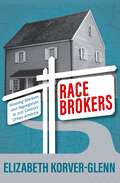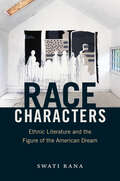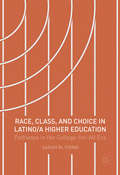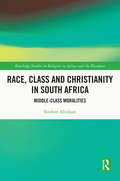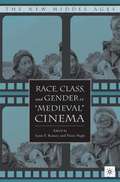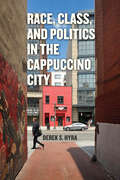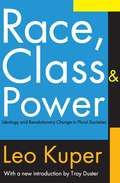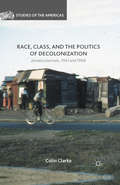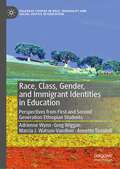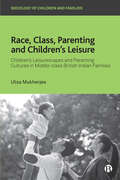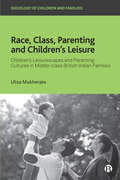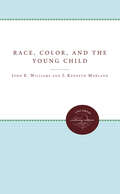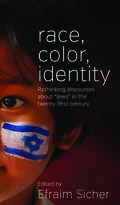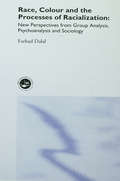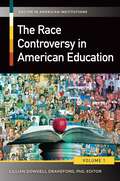- Table View
- List View
Race Brokers: Housing Markets and Segregation in 21st Century Urban America
by Elizabeth Korver-GlennHow is it that America's cities remain almost as segregated as they were fifty years ago? In Race Brokers, Elizabeth Korver-Glenn examines how housing market professionals--including housing developers, real estate agents, mortgage lenders, and appraisers--construct contemporary urban housing markets in ways that contribute to neighborhood inequality and racial segregation. Drawing on extensive ethnographic and interview data collected in Houston, Texas, Korver-Glenn shows how these professionals, especially those who are White, use racist tools to build a fundamentally unequal housing market and are even encouraged to apply racist ideas to market activity and interactions. Korver-Glenn further tracks how professionals broker racism across the entirety of the housing exchange process--from the home's construction, to real estate brokerage, mortgage lending, home appraisals, and the home sale closing. Race Brokers highlights the imperative to interrupt the racism that pervades housing market professionals' work, dismantle the racialized routines that underwrite such racism, and cultivate a truly fair housing market.
Race Characters: Ethnic Literature and the Figure of the American Dream
by Swati RanaA vexed figure inhabits U.S. literature and culture: the visibly racialized immigrant who disavows minority identity and embraces the American dream. Such figures are potent and controversial, for they promise to expiate racial violence and perpetuate an exceptionalist ideal of America. Swati Rana grapples with these figures, building on studies of literary character and racial form. Rana offers a new way to view characterization through racialization that creates a fuller social reading of race. Situated in a nascent period of ethnic identification from 1900 to 1960, this book focuses on immigrant writers who do not fit neatly into a resistance-based model of ethnic literature. Writings by Paule Marshall, Ameen Rihani, Dalip Singh Saund, Jose Garcia Villa, and Jose Antonio Villarreal symbolize different aspects of the American dream, from individualism to imperialism, assimilation to upward mobility. The dynamics of characterization are also those of contestation, Rana argues. Analyzing the interrelation of persona and personhood, Race Characters presents an original method of comparison, revealing how the protagonist of the American dream is socially constrained and structurally driven.
Race Characters: Ethnic Literature and the Figure of the American Dream
by Swati RanaA vexed figure inhabits U.S. literature and culture: the visibly racialized immigrant who disavows minority identity and embraces the American dream. Such figures are potent and controversial, for they promise to expiate racial violence and perpetuate an exceptionalist ideal of America. Swati Rana grapples with these figures, building on studies of literary character and racial form. Rana offers a new way to view characterization through racialization that creates a fuller social reading of race. Situated in a nascent period of ethnic identification from 1900 to 1960, this book focuses on immigrant writers who do not fit neatly into a resistance-based model of ethnic literature. Writings by Paule Marshall, Ameen Rihani, Dalip Singh Saund, Jose Garcia Villa, and Jose Antonio Villarreal symbolize different aspects of the American dream, from individualism to imperialism, assimilation to upward mobility. The dynamics of characterization are also those of contestation, Rana argues. Analyzing the interrelation of persona and personhood, Race Characters presents an original method of comparison, revealing how the protagonist of the American dream is socially constrained and structurally driven.
Race Characters: Ethnic Literature and the Figure of the American Dream
by Swati RanaA vexed figure inhabits U.S. literature and culture: the visibly racialized immigrant who disavows minority identity and embraces the American dream. Such figures are potent and controversial, for they promise to expiate racial violence and perpetuate an exceptionalist ideal of America. Swati Rana grapples with these figures, building on studies of literary character and racial form. Rana offers a new way to view characterization through racialization that creates a fuller social reading of race. Situated in a nascent period of ethnic identification from 1900 to 1960, this book focuses on immigrant writers who do not fit neatly into a resistance-based model of ethnic literature. Writings by Paule Marshall, Ameen Rihani, Dalip Singh Saund, Jose Garcia Villa, and Jose Antonio Villarreal symbolize different aspects of the American dream, from individualism to imperialism, assimilation to upward mobility. The dynamics of characterization are also those of contestation, Rana argues. Analyzing the interrelation of persona and personhood, Race Characters presents an original method of comparison, revealing how the protagonist of the American dream is socially constrained and structurally driven.
Race, Class, and Choice in Latino/a Higher Education: Pathways in the College-for-All Era
by Sarah M OvinkThis book is an in-depth study which examines the lives of fifty ambitious Latino/a high school seniors in the San Francisco East Bay Area, following their entrance into college and career pathways over several years. This book examines the social forces that contributed to near-universal college attendance among these mostly low-income Latinos/as, all of whom attended fairly typical public schools. In an era of increased economic insecurity, decreased funding for schools, and rising college tuition, this book provides a balanced look at the individual choices and systemic constraints influencing today’s “college-for-all” orientation, while pointing the way toward possibilities for making college pathways smoother for all.
Race, Class and Christianity in South Africa: Middle-Class Moralities (Routledge Studies on Religion in Africa and the Diaspora)
by Ibrahim AbrahamThis book explores the relationship between race and class among middle-class Christians in South Africa. The book provides a theoretically sophisticated and empirically rich study of middle-class Christians in contemporary South Africa, as they seek to live good lives and build a good society. Focused on the city of Cape Town, drawing upon ethnographic research in conservative and progressive multiracial Protestant churches, furnished with critical analysis of South African literature and popular culture, this timely study explores expressions of ambition and anxiety that are both spiritual and material. Building upon debates over middle-class identity and morality from sociology, anthropology, and cultural studies, this book analyses congregational attempts at social unity through worship music and creative youth ministry, discussions on white privilege and shame, and the impact of middle-class black activism in South African churches and society. This book will be of interest to researchers of South African culture and society, religion, anthropology, and sociology.
Race, Class and Christianity in South Africa: Middle-Class Moralities (Routledge Studies on Religion in Africa and the Diaspora)
by Ibrahim AbrahamThis book explores the relationship between race and class among middle-class Christians in South Africa. The book provides a theoretically sophisticated and empirically rich study of middle-class Christians in contemporary South Africa, as they seek to live good lives and build a good society. Focused on the city of Cape Town, drawing upon ethnographic research in conservative and progressive multiracial Protestant churches, furnished with critical analysis of South African literature and popular culture, this timely study explores expressions of ambition and anxiety that are both spiritual and material. Building upon debates over middle-class identity and morality from sociology, anthropology, and cultural studies, this book analyses congregational attempts at social unity through worship music and creative youth ministry, discussions on white privilege and shame, and the impact of middle-class black activism in South African churches and society. This book will be of interest to researchers of South African culture and society, religion, anthropology, and sociology.
Race, Class, and Gender in "Medieval" Cinema (The New Middle Ages)
by L. Ramey T. PughThe medieval film genre is not, in general, concerned with constructing a historically accurate past, but much analysis nonetheless centers on highlighting anachronisms. This book aims to help scholars and aficionados of medieval film think about how the re-creation of an often mythical past performs important cultural work for modern directors and viewers. The essays in this collection demonstrate that directors intentionally insert modern preoccupations into a setting that would normally be considered incompatible with these concepts. The Middle Ages provide an imaginary space far enough removed from the present day to explore modern preoccupations with human identity.
Race, Class, and Politics in the Cappuccino City
by Derek S. HyraFor long-time residents of Washington, DC’s Shaw/U Street, the neighborhood has become almost unrecognizable in recent years. Where the city’s most infamous open-air drug market once stood, a farmers’ market now sells grass-fed beef and homemade duck egg ravioli. On the corner where AM.PM carryout used to dish out soul food, a new establishment markets its $28 foie gras burger. Shaw is experiencing a dramatic transformation, from “ghetto” to “gilded ghetto,” where white newcomers are rehabbing homes, developing dog parks, and paving the way for a third wave coffee shop on nearly every block. Race, Class, and Politics in the Cappuccino City is an in-depth ethnography of this gilded ghetto. Derek S. Hyra captures here a quickly gentrifying space in which long-time black residents are joined, and variously displaced, by an influx of young, white, relatively wealthy, and/or gay professionals who, in part as a result of global economic forces and the recent development of central business districts, have returned to the cities earlier generations fled decades ago. As a result, America is witnessing the emergence of what Hyra calls “cappuccino cities.” A cappuccino has essentially the same ingredients as a cup of coffee with milk, but is considered upscale, and is double the price. In Hyra’s cappuccino city, the black inner-city neighborhood undergoes enormous transformations and becomes racially “lighter” and more expensive by the year.
Race, Class, and Politics in the Cappuccino City
by Derek S. HyraFor long-time residents of Washington, DC’s Shaw/U Street, the neighborhood has become almost unrecognizable in recent years. Where the city’s most infamous open-air drug market once stood, a farmers’ market now sells grass-fed beef and homemade duck egg ravioli. On the corner where AM.PM carryout used to dish out soul food, a new establishment markets its $28 foie gras burger. Shaw is experiencing a dramatic transformation, from “ghetto” to “gilded ghetto,” where white newcomers are rehabbing homes, developing dog parks, and paving the way for a third wave coffee shop on nearly every block. Race, Class, and Politics in the Cappuccino City is an in-depth ethnography of this gilded ghetto. Derek S. Hyra captures here a quickly gentrifying space in which long-time black residents are joined, and variously displaced, by an influx of young, white, relatively wealthy, and/or gay professionals who, in part as a result of global economic forces and the recent development of central business districts, have returned to the cities earlier generations fled decades ago. As a result, America is witnessing the emergence of what Hyra calls “cappuccino cities.” A cappuccino has essentially the same ingredients as a cup of coffee with milk, but is considered upscale, and is double the price. In Hyra’s cappuccino city, the black inner-city neighborhood undergoes enormous transformations and becomes racially “lighter” and more expensive by the year.
Race, Class, and Politics in the Cappuccino City
by Derek S. HyraFor long-time residents of Washington, DC’s Shaw/U Street, the neighborhood has become almost unrecognizable in recent years. Where the city’s most infamous open-air drug market once stood, a farmers’ market now sells grass-fed beef and homemade duck egg ravioli. On the corner where AM.PM carryout used to dish out soul food, a new establishment markets its $28 foie gras burger. Shaw is experiencing a dramatic transformation, from “ghetto” to “gilded ghetto,” where white newcomers are rehabbing homes, developing dog parks, and paving the way for a third wave coffee shop on nearly every block. Race, Class, and Politics in the Cappuccino City is an in-depth ethnography of this gilded ghetto. Derek S. Hyra captures here a quickly gentrifying space in which long-time black residents are joined, and variously displaced, by an influx of young, white, relatively wealthy, and/or gay professionals who, in part as a result of global economic forces and the recent development of central business districts, have returned to the cities earlier generations fled decades ago. As a result, America is witnessing the emergence of what Hyra calls “cappuccino cities.” A cappuccino has essentially the same ingredients as a cup of coffee with milk, but is considered upscale, and is double the price. In Hyra’s cappuccino city, the black inner-city neighborhood undergoes enormous transformations and becomes racially “lighter” and more expensive by the year.
Race, Class, and Politics in the Cappuccino City
by Derek S. HyraFor long-time residents of Washington, DC’s Shaw/U Street, the neighborhood has become almost unrecognizable in recent years. Where the city’s most infamous open-air drug market once stood, a farmers’ market now sells grass-fed beef and homemade duck egg ravioli. On the corner where AM.PM carryout used to dish out soul food, a new establishment markets its $28 foie gras burger. Shaw is experiencing a dramatic transformation, from “ghetto” to “gilded ghetto,” where white newcomers are rehabbing homes, developing dog parks, and paving the way for a third wave coffee shop on nearly every block. Race, Class, and Politics in the Cappuccino City is an in-depth ethnography of this gilded ghetto. Derek S. Hyra captures here a quickly gentrifying space in which long-time black residents are joined, and variously displaced, by an influx of young, white, relatively wealthy, and/or gay professionals who, in part as a result of global economic forces and the recent development of central business districts, have returned to the cities earlier generations fled decades ago. As a result, America is witnessing the emergence of what Hyra calls “cappuccino cities.” A cappuccino has essentially the same ingredients as a cup of coffee with milk, but is considered upscale, and is double the price. In Hyra’s cappuccino city, the black inner-city neighborhood undergoes enormous transformations and becomes racially “lighter” and more expensive by the year.
Race, Class, and Politics in the Cappuccino City
by Derek S. HyraFor long-time residents of Washington, DC’s Shaw/U Street, the neighborhood has become almost unrecognizable in recent years. Where the city’s most infamous open-air drug market once stood, a farmers’ market now sells grass-fed beef and homemade duck egg ravioli. On the corner where AM.PM carryout used to dish out soul food, a new establishment markets its $28 foie gras burger. Shaw is experiencing a dramatic transformation, from “ghetto” to “gilded ghetto,” where white newcomers are rehabbing homes, developing dog parks, and paving the way for a third wave coffee shop on nearly every block. Race, Class, and Politics in the Cappuccino City is an in-depth ethnography of this gilded ghetto. Derek S. Hyra captures here a quickly gentrifying space in which long-time black residents are joined, and variously displaced, by an influx of young, white, relatively wealthy, and/or gay professionals who, in part as a result of global economic forces and the recent development of central business districts, have returned to the cities earlier generations fled decades ago. As a result, America is witnessing the emergence of what Hyra calls “cappuccino cities.” A cappuccino has essentially the same ingredients as a cup of coffee with milk, but is considered upscale, and is double the price. In Hyra’s cappuccino city, the black inner-city neighborhood undergoes enormous transformations and becomes racially “lighter” and more expensive by the year.
Race, Class, and Politics in the Cappuccino City
by Derek S. HyraFor long-time residents of Washington, DC’s Shaw/U Street, the neighborhood has become almost unrecognizable in recent years. Where the city’s most infamous open-air drug market once stood, a farmers’ market now sells grass-fed beef and homemade duck egg ravioli. On the corner where AM.PM carryout used to dish out soul food, a new establishment markets its $28 foie gras burger. Shaw is experiencing a dramatic transformation, from “ghetto” to “gilded ghetto,” where white newcomers are rehabbing homes, developing dog parks, and paving the way for a third wave coffee shop on nearly every block. Race, Class, and Politics in the Cappuccino City is an in-depth ethnography of this gilded ghetto. Derek S. Hyra captures here a quickly gentrifying space in which long-time black residents are joined, and variously displaced, by an influx of young, white, relatively wealthy, and/or gay professionals who, in part as a result of global economic forces and the recent development of central business districts, have returned to the cities earlier generations fled decades ago. As a result, America is witnessing the emergence of what Hyra calls “cappuccino cities.” A cappuccino has essentially the same ingredients as a cup of coffee with milk, but is considered upscale, and is double the price. In Hyra’s cappuccino city, the black inner-city neighborhood undergoes enormous transformations and becomes racially “lighter” and more expensive by the year.
Race, Class, and Power: Ideology and Revolutionary Change in Plural Societies
by Leo KuperExamining in detail the apparently inexorable polarization of society in such countries as Rwanda, Algeria, and South Africa, the author questions whether current theories correctly explain the past or offer adequate guides for the future. In their place he puts forward an alternative neo-Durkheimian view of the possibility of non-violent revolutionary change, based on the development of such social and cultural continuities as already exist within each plural society. But he warns that -this is an age of passionate commitment to violence in which vicarious killers abound in search of a Vietnam of their own.- The aim of this groundbreaking and challenging book is to create theoretical perspectives in which to view the racial conflict of plural societies. Written in the turbulent early 1970s, the book demonstrates the inadequacy of then prevailing views such as Marxist interpretations of racial conflict as class struggle, and the Fanon a priori rejection of non-violent techniques of change, which Kuper holds responsible for the acceptance of what he calls -the platitudes of violence.- The book concludes with more personal sections focusing on the author's struggles with the then prevailing South African society, critiques of that, and censorship of his attempts to make these public. In the light of subsequent changes in South Africa many decades later, this book serves not only as an important work of political sociology but as a personal testament to the fight against racism in South Africa. Leo Kuper was professor of sociology and director of the African Studies Center at the University of California, Los Angeles. A South African by birth, he was one of the first writers on genocide as well as other aspects of African studies and urban sociology. His major book, Genocide (Penguin, 1981), remains in print. The Leo Kuper Foundation is a non-governmental organization dedicated to the eradication of genocide through research, advice, and education. It was created in Washington, DC in 1994 following the death of Leo Kuper, with the aim of improving measures to prevent genocide. The main area of work for the past five years has been in support of the creation of an International Criminal Court. Troy Duster is director at the Institute for the History of the Production of Knowledge, New York University.
Race, Class, and Power: Ideology and Revolutionary Change in Plural Societies
by Leo KuperExamining in detail the apparently inexorable polarization of society in such countries as Rwanda, Algeria, and South Africa, the author questions whether current theories correctly explain the past or offer adequate guides for the future. In their place he puts forward an alternative neo-Durkheimian view of the possibility of non-violent revolutionary change, based on the development of such social and cultural continuities as already exist within each plural society. But he warns that -this is an age of passionate commitment to violence in which vicarious killers abound in search of a Vietnam of their own.- The aim of this groundbreaking and challenging book is to create theoretical perspectives in which to view the racial conflict of plural societies. Written in the turbulent early 1970s, the book demonstrates the inadequacy of then prevailing views such as Marxist interpretations of racial conflict as class struggle, and the Fanon a priori rejection of non-violent techniques of change, which Kuper holds responsible for the acceptance of what he calls -the platitudes of violence.- The book concludes with more personal sections focusing on the author's struggles with the then prevailing South African society, critiques of that, and censorship of his attempts to make these public. In the light of subsequent changes in South Africa many decades later, this book serves not only as an important work of political sociology but as a personal testament to the fight against racism in South Africa. Leo Kuper was professor of sociology and director of the African Studies Center at the University of California, Los Angeles. A South African by birth, he was one of the first writers on genocide as well as other aspects of African studies and urban sociology. His major book, Genocide (Penguin, 1981), remains in print. The Leo Kuper Foundation is a non-governmental organization dedicated to the eradication of genocide through research, advice, and education. It was created in Washington, DC in 1994 following the death of Leo Kuper, with the aim of improving measures to prevent genocide. The main area of work for the past five years has been in support of the creation of an International Criminal Court. Troy Duster is director at the Institute for the History of the Production of Knowledge, New York University.
Race, Class, and the Politics of Decolonization: Jamaica Journals, 1961 and 1968 (Studies of the Americas)
by Colin ClarkeThis book offers a detailed picture of Jamaica before and after independence. A 1961 journal sheds light on the political and social context before independence, while a 1968 journal shows how independence dissolved dissident forces and identifies the origins of Jamaica's current two party politics.
Race, Class, Gender, and Immigrant Identities in Education: Perspectives from First and Second Generation Ethiopian Students (Palgrave Studies in Race, Inequality and Social Justice in Education)
by Adrienne Wynn Greg Wiggan Marcia J. Watson-Vandiver Annette TeasdellThis volume addresses the underlying intersections of race, class, and gender on immigrant girls’ experiences living in the US. It examines the impact of acculturation and assimilation on Ethiopian girls’ academic achievement, self-identity, and perception of beauty. The authors employ Critical Race Theory, Critical Race Feminism, and Afrocentricity to situate the study and unpack the narratives shared by these newcomers as they navigate social contexts rife with racism, xenophobia, and other forms of oppression. Lastly, the authors examine the implications of Ethiopian immigrant identities and experiences within multicultural education, policy development, and society.
Race, Class, Parenting and Children’s Leisure: Children’s Leisurescapes and Parenting Cultures in Middle-class British Indian Families (Sociology of Children and Families)
by Utsa MukherjeeChildren’s leisure lives are changing, with increasing dominance of organised activities and screen-based leisure. These shifts have reconfigured parenting practices, too. However, our current understandings of these processes are race-blind and based mostly on the experiences of white middle-class families. Drawing on an innovative study of middle-class British Indian families, this book brings children’s and parents’ voices to the forefront and bridges childhood studies, family studies and leisure studies to theorise children’s leisure from a fresh perspective. Demonstrating the salience of both race and class in shaping leisure cultures within middle-class racialised families, this is an invaluable contribution to key sociological debates around leisure, childhoods and parenting ideologies.
Race, Class, Parenting and Children’s Leisure: Children’s Leisurescapes and Parenting Cultures in Middle-class British Indian Families (Sociology of Children and Families)
by Utsa MukherjeeChildren’s leisure lives are changing, with increasing dominance of organised activities and screen-based leisure. These shifts have reconfigured parenting practices, too. However, our current understandings of these processes are race-blind and based mostly on the experiences of white middle-class families. Drawing on an innovative study of middle-class British Indian families, this book brings children’s and parents’ voices to the forefront and bridges childhood studies, family studies and leisure studies to theorise children’s leisure from a fresh perspective. Demonstrating the salience of both race and class in shaping leisure cultures within middle-class racialised families, this is an invaluable contribution to key sociological debates around leisure, childhoods and parenting ideologies.
Race, Color, and the Young Child
by John Williams J. Kenneth MorlandA social-developmental psychologist and a social anthropologist describe what is known--and what needs to be investigated--concerning the development of race and color concepts in young children. The authors summarize the results of their fifteen-year research and integrate their findings with those of other investigators to provide, in a single source, a much-needed summary of the research literature and a more comprehensive theoretical analysis than has appeared previously.Originally published in 1976.A UNC Press Enduring Edition -- UNC Press Enduring Editions use the latest in digital technology to make available again books from our distinguished backlist that were previously out of print. These editions are published unaltered from the original, and are presented in affordable paperback formats, bringing readers both historical and cultural value.
Race, Color, Identity: Rethinking Discourses about 'Jews' in the Twenty-First Century
by Efraim SicherAdvances in genetics are renewing controversies over inherited characteristics, and the discourse around science and technological innovations has taken on racial overtones, such as attributing inherited physiological traits to certain ethnic groups or using DNA testing to determine biological links with ethnic ancestry. This book contributes to the discussion by opening up previously locked concepts of the relation between the terms color, race, and “Jews”, and by engaging with globalism, multiculturalism, hybridity, and diaspora. The contributors—leading scholars in anthropology, sociology, history, literature, and cultural studies—discuss how it is not merely a question of whether Jews are acknowledged to be interracial, but how to address academic and social discourses that continue to place Jews and others in a race/color category.
Race, Colour and the Processes of Racialization: New Perspectives from Group Analysis, Psychoanalysis and Sociology
by Farhad DalalIs racial conflict determined by biology or society?So many conflicts appear to be caused by racial and ethnic differences; for example, the cities of Britain and America are regularly affected by race riots. It is argued by socio-biologists and some schools of psychoanalysis that our instincts are programmed to hate those different to us by evolutionary and developmental mechanisms. This book argues against this line, proposing an alternative drawing on insights from diverse disciplines including anthropology, social psychology and linguistics, to give power-relations a critical explanatory role in the generation of hatreds. Farhad Dalal argues that people differentiate between races in order to make a distinction between the 'haves' and 'must-not-haves', and that this process is cognitive, emotional and political rather than biological. Examining the subject over the past thousand years, Race, Colour and the Processes of Racialisation covers:* psychoanalytic and other theories of racism* a new theorisation of racism based on group analytic theory* a general theory of difference based on the works of Fanon, Elias, Matte-Blanco and Foulkes* application of this theory to race and racism.Farhad Dalal concludes that the structures of society are reflected in the structures of the psyche, and both of these are colour coded. This book will be invaluable to students, academics and practitioners in the areas of psychoanalysis, group analysis, psychotherapy and counselling.
Race, Colour and the Processes of Racialization: New Perspectives from Group Analysis, Psychoanalysis and Sociology
by Farhad DalalIs racial conflict determined by biology or society?So many conflicts appear to be caused by racial and ethnic differences; for example, the cities of Britain and America are regularly affected by race riots. It is argued by socio-biologists and some schools of psychoanalysis that our instincts are programmed to hate those different to us by evolutionary and developmental mechanisms. This book argues against this line, proposing an alternative drawing on insights from diverse disciplines including anthropology, social psychology and linguistics, to give power-relations a critical explanatory role in the generation of hatreds. Farhad Dalal argues that people differentiate between races in order to make a distinction between the 'haves' and 'must-not-haves', and that this process is cognitive, emotional and political rather than biological. Examining the subject over the past thousand years, Race, Colour and the Processes of Racialisation covers:* psychoanalytic and other theories of racism* a new theorisation of racism based on group analytic theory* a general theory of difference based on the works of Fanon, Elias, Matte-Blanco and Foulkes* application of this theory to race and racism.Farhad Dalal concludes that the structures of society are reflected in the structures of the psyche, and both of these are colour coded. This book will be invaluable to students, academics and practitioners in the areas of psychoanalysis, group analysis, psychotherapy and counselling.
The Race Controversy in American Education [2 volumes]: [2 volumes] (Racism in American Institutions)
by Lillian Dowdell Drakeford Brian D. BehnkenIn this unique two-volume work, expert scholars and practitioners examine race and racism in public education, tackling controversial educational issues such as the school-to-prison pipeline, charter schools, school funding, affirmative action, and racialized curricula.This work is built on the premise that recent efforts to advance color-blind, race-neutral educational policies and reforms have not only proven ineffective in achieving racial equity and equality of educational opportunities and outcomes in America's public schools but also exacerbated existing inequalities. That point is made through a collection of essays that examine the consequences of racial inequality on the school experience and success of students of color and other historically marginalized populations.Addressing K–12 education and higher education in historically black as well as predominantly white institutions, the work probes the impact of race and racism on education policies and reforms to determine the role schools, school processes, and school structures play in the perpetuation of racial inequality in American education. Each volume validates the impact of race on teaching and learning and exposes the ways in which racism manifests itself in U.S. schools. In addition, practical recommendations are presented that may be used to confront and eradicate racism in education. By exposing what happens when issues of race and racism are marginalized or ignored, this collection will prepare readers to resist—and perhaps finally overcome—the racial inequality that plagues America's schools.
